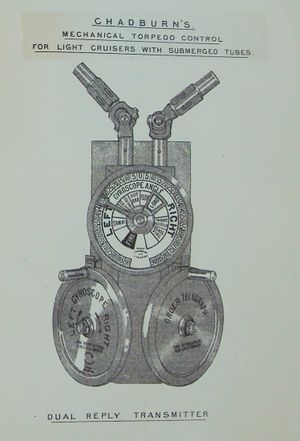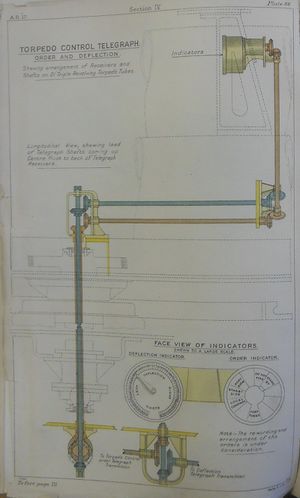Chadburn's Torpedo Telegraph

Chadburn's Torpedo Telegraph was a mechanical British system for reliably communicating torpedo orders, similar in design and function to the mechanical engine room telegraphs the Chadburn company was known for. It was used as an alternative to Barr and Stroud torpedo control instruments as well as the Wise Pressure Telegraphy System.
Nature and Function
Rotating shafts had long been used to convey engine room orders, as they proved reliable and did not suffer when traversing the high temperatures of a boiler room. On special wrinkle that this application created for trainable torpedo tubes was the need to rotate with the torpedo mount. The clever mechanism which required a telescoping shaft is depicted to the right.
Submerged Tube Model
Intended for light cruisers with submerged tubes, it was capable of sending gyro angles from 0 to 90 degrees (seemingly 50 degrees more than the maximum the torpedoes could do), left or right, in 5 degree increments as had become the norm for the torpedoes.
The orders it could send included:[2]
- CEASE FIRE
- IN BAR AND DRAIN
- LOAD
- FLOOD
- OUTBAR
- CLOSE (illegible) DOOR ON TUBE (?)
- STAND BY
- FIRE
- 4 blank sectors available for future use
A pair of hand-wheels identical to those on Chadburn's revolution and engine room telegraphs set gyro angle (on left) and order (on right), each handle altering its datum by one position per revolution. The handle was always to remain at the twelve o'clock position when not being moved. Torsional rods and universal joints transmitted the indication to the receiver.
Above-Water Tube Model

Less is known about the destroyer model for want of an image of its dial(s). It appears from the plate to have but a single indication, which is very likely deflection. I assume that orders would be relegated to telaupad or voice pipe systems already in place.
Allocation

After Jutland, the Royal Navy decided on standard schemes for torpedo control for its various vessels. Light cruisers and destroyers were good candidate to receive simple, robust solutions for communicating torpedo orders.[5] Diversifying away from Barr and Stroud's electro-mechanical systems may well have also helped shift work away from that much-burdened vendor.[Inference]
In 1916, it was decided to give light cruisers with submerged tubes systems for communicating gyro angles and torpedo orders with a similar means of indicating replies. While others received Barr and Stroud equipment, the Birkenhead and Calliope classes were selected to receive Chadburn systems with mechanical replies between fore bridge and the torpedo flats. Those vessels with an after control position would have a second, separate outfit from that to the torpedo flat, doubling the hardware in the flat. Firing was to be by command or by electrical firing keys on the fore bridge.[6]
At the same time, light cruisers of the Arethusa class with above-water tubes and destroyers of "K" class and later needed similar control arrangements. Of these, those ships with the early "Type A" Wise pressure telegraphs (Inconstant, Nepean, Nereus and Partridge) would have those modified to transmit only deflection and receive Chadburn systems for orders only (see below).
By late 1917, the gear was described as "having given every satisfaction in the vessels in which it was first tried", and so its use was to be extended to the D.R. and T.R. tubes of the latest flotilla leaders and the "S" and "W" class destroyers.[7]
Torpedo Order Telegraph
As the Royal Navy tried to rapidly consolidate its post-Jutland ideas of torpedo control on light cruisers and destroyers, it proved convenient to have Chadburn devices provide the torpedo orders (only) for 16 ships which would retain their "Type B" Wise Pressure System for deflection (only). Chadburn delivered a variation on their standard engine room telegraph for this purpose. Presumably, the orders were identical to those on the dual telegraph pictured above.[8]
Alterations
Although the transmitters were not very large devices, the constraints of space on the bridge of destroyers and such mandated the adoption of hinged drop-handles that reduced the projection into belt-loop-grabbing space.[9][10]
In 1923, Campbell, Veteran, Witherington, Wild Swan and Wolverine were given new, opalescent glass dials with 16 orders for their Chadburn's equipment, an increase from the 12 orders in the original design. They required new gearing to match. It was resolved that further installations of this type should occur "as soon as financial conditions permit of it."[11]
Footnotes
- ↑ Annual Report of the Torpedo School, 1916. Plate 67.
- ↑ Annual Report of the Torpedo School, 1916. Plate 67.
- ↑ Annual Report of the Torpedo School, 1916. Plate 4.
- ↑ Annual Report of the Torpedo School, 1917. Plate 86.
- ↑ Annual Report of the Torpedo School, 1916. pp. 28-30.
- ↑ Annual Report of the Torpedo School, 1916. p. 30. (A.L.G. 25883/16).
- ↑ Annual Report of the Torpedo School, 1917. p. 211.
- ↑ Annual Report of the Torpedo School, 1916. p. 30.
- ↑ Annual Report of the Torpedo School, 1919. p. 155.
- ↑ Annual Report of the Torpedo School, 1918. Plate 141.
- ↑ Annual Report of the Torpedo School, 1923. p. 136.
Bibliography